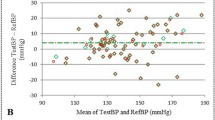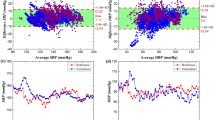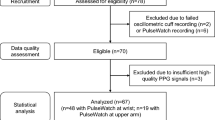Abstract
Ambulatory blood pressure monitoring (ABPM) has become an essential tool in the diagnosis and management of hypertension. Current standard ABPM devices use an oscillometric cuff-based method which can cause physical discomfort to the patients with repeated inflations and deflations, especially during nighttime leading to sleep disturbance. The ability to measure ambulatory BP accurately and comfortably without a cuff would be attractive. This study validated the accuracy of a cuff-less approach for ABPM using pulse arrival time (PAT) measurements on both healthy and hypertensive subjects for potential use in hypertensive management, which is the first of its kind. The wearable cuff-less device was evaluated against a standard cuff-based device on 24 subjects of which 15 have known hypertension. BP measurements were taken from each subject over a 24-h period by the cuff-less and cuff-based devices every 15 to 30 minutes during daily activities. Mean BP of each subject during daytime, nighttime and over 24-h were calculated. Agreement between mean nighttime systolic BP (SBP) and diastolic (DBP) measured by the two devices evaluated using Bland-Altman plot were −1.4 ± 6.6 and 0.4 ± 6.7 mmHg, respectively. Receiver operator characteristics (ROC) statistics was used to assess the diagnostic accuracy of the cuff-less approach in the detection of BP above the hypertension threshold during nighttime (>120/70 mmHg). The area under ROC curves were 0.975/0.79 for nighttime. The results suggest that PAT-based approach is accurate and promising for ABPM without the issue of sleep disturbances associated with cuff-based devices.







Similar content being viewed by others
References
Mancia, G., Fagard, R., Narkiewicz, K., Redon, J., Zanchetti, A., et al., 2013 ESH/ESC guidelines for the management of arterial hypertension: the task force for the management of arterial hypertension of the European Society of Hypertension (ESH) and of the European Society of Cardiology (ESC). Eur. Heart J. 34:2159–2219, 2013. doi:10.1093/eurheartj/eht151.
Fagard, R.H., Celis, H., Thijs, L., Staessen, J.A., Clement, D.L., De Buyzere, M.L., and De Bacquer, D.A., Daytime and nighttime blood pressure as predictors of death and cause-specific cardiovascular events in hypertension. Hypertension. 51:55–61, 2008. doi:10.1161/hypertensionaha.107.100727.
Niiranen, T.J., Maki, J., Puukka, P., Karanko, H., and Jula, A.M., Office, home, and ambulatory blood pressures as predictors of cardiovascular risk. Hypertension. 64:281–286, 2014. doi:10.1161/hypertensionaha.114.03292.
Yi, J.E., Shin, J., Ihm, S.H., Kim, J.H., Park, S., et al., Not nondipping but nocturnal blood pressure predicts left ventricular hypertrophy in the essential hypertensive patients: the Korean ambulatory blood pressure multicenter observational study. J. Hypertens. 32:1999–2004, 2014. doi:10.1097/hjh.0000000000000272.
Mancia, G., Zanchetti, A., Agebiti-Rosei, E., Benemio, G., De Cesaris, R., et al., Ambulatory blood pressure is superior to clinic blood pressure in predicting treatment-induced regression of left ventricular hypertrophy. Circulation. 95:1464–1470, 1997. doi:10.1161/01.cir.95.6.1464.
Karpettas, N., Destounis, A., Kollias, A., Nasothimiou, E., Moyssakis, I., and Stergiou, G.S., Prediction of treatment-induced changes in target-organ damage using changes in clinic, home and ambulatory blood pressure. Hypertens. Res. 37:543–547, 2014. doi:10.1038/hr.2014.24.
Baig, M.M., and Gholamhosseini, H., Smart Health Monitoring Systems: An Overview of Design and Modeling. J. Med. Syst. 37, 2013. doi:10.1007/s10916-012-9898-z.
Steinhubl, S.R., Muse, E.D., and Topol, E.J., The emerging field of mobile health. Sci. Transl. Med. 7:1–6, 2015.
Or C, Tao D (2016) A 3-Month Randomized Controlled Pilot Trial of a Patient-Centered, Computer-Based Self-Monitoring System for the Care of Type 2 Diabetes Mellitus and Hypertension. J Med Syst 40. doi:10.1007/s10916–016–0437-1
Rudner J, McDougall C, Sailam V, Smith M, Sacchetti A Interrogation of Patient Smartphone Activity Tracker to Assist Arrhythmia Management. Annals of Emergency Medicine. doi:10.1016/j.annemergmed.2016.02.039 2016.
Agarwal, R., and Light, R.P., The effect of measuring ambulatory blood pressure on nighttime sleep and daytime activity—implications for dipping. Clin. J. Am. Soc. Nephrol. 5:281–285, 2010.
Zhilin, Z., Photoplethysmography-based heart rate monitoring in physical activities via joint sparse Spectrum reconstruction. Biomed. Eng. IEEE Trans. on. 62:1902–1910, 2015. doi:10.1109/TBME.2015.2406332.
Feissel, M., Aho, L.S., Georgiev, S., Tapponnier, R., Badie, J., Bruyere, R., and Quenot, J.P., Pulse Wave Transit Time Measurements of Cardiac Output in Septic Shock Patients: A Comparison of the Estimated Continuous Cardiac Output System with Transthoracic Echocardiography. Plos One:10, 2015. doi:10.1371/journal.pone.0130489.
Ruiz-Rodríguez, J., Ruiz-Sanmartín, A., Ribas, V., Caballero, J., García-Roche, A., et al., Innovative continuous non-invasive cuffless blood pressure monitoring based on photoplethysmography technology. Intensive Care Med. 39:1618–1625, 2013. doi:10.1007/s00134-013-2964-2.
Mukkamala, R., Hahn, J.O., Inan, O.T., Mestha, L.K., Kim, C.S., Toreyin, H., and Kyal, S., Toward ubiquitous blood pressure monitoring via pulse transit time: theory and practice. IEEE Trans. Biomed. Eng. 62:1879–1901, 2015. doi:10.1109/TBME.2015.2441951.
Poon CCY, Zhang YT Cuff-less and noninvasive measurements of arterial blood pressure by pulse transit time. In: Proc. 27th Annu. Int. Conf. IEEE-EMBC, Shanghai, pp 5877–5880 2005
Gesche, H., Grosskurth, D., Küchler, G., and Patzak, A., Continuous blood pressure measurement by using the pulse transit time: comparison to a cuff-based method. Eur. J. Appl. Physiol. 112:1–7, 2011. doi:10.1007/s00421-011-1983-3.
Kim, S.H., Song, J.G., Park, J.H., Kim, J.W., Park, Y.S., and Hwang, G.S., Beat-to-beat tracking of systolic blood pressure using noninvasive pulse transit time during anesthesia induction in hypertensive patients. Anesth. Analg. 116:94–100, 2013. doi:10.1213/ANE.0b013e318270a6d9.
Zheng YL, Leung B, Sy S, Zhang YT, Poon CCY A clip-free eyeglasses-based wearable monitoring device for measuring photoplethysmograhic signals. In: Proceedings of the 34th Annual International Conference of the IEEE Engineering in Medicine and Biology Society, San Diego. pp 5022–5025 2012
Winokur ES, He DD, Sodini, CG A wearable vital signs monitor at the ear for continuous heart rate and pulse transit time measurements. In: Proc. 34th Annu. Int. Conf. IEEE-EMBC, San Diego, CA, Aug. pp 2724–2727. doi:10.1109/embc.2012.6346527 2012.
Lin, H., Xu, W., Guan, N., Ji, D., Wei, Y., and Yi, W., Noninvasive and continuous blood pressure monitoring using wearable body sensor networks. IEEE Intell. Syst. 30:38–48, 2015. doi:10.1109/MIS.2015.72.
Dilpreet, B., Jean-Michel, R., and Mehmet Rasit, Y., A survey on signals and systems in ambulatory blood pressure monitoring using pulse transit time. Physiol. Meas. 36:R1, 2015.
Jeong, I.C., and Finkelstein, J., Introducing contactless blood pressure assessment using a high speed video camera. J. Med. Syst. 40:1–10, 2016. doi:10.1007/s10916-016-0439-z.
McCarthy, B., Vaughan, C., O'Flynn, B., Mathewson, A., and Mathúna, C.Ó., An examination of calibration intervals required for accurately tracking blood pressure using pulse transit time algorithms. J. Hum. Hypertens. 27:744–750, 2013.
Zheng, Y.L., Yan, B.P., Zhang, Y.T., and Poon, C.C.Y., An armband wearable device for overnight and cuff-less blood pressure measurement. IEEE. Trans. Biomed. Eng. 61:2179–2186, 2014. doi:10.1109/tbme.2014.2318779.
Pickering, T.G., Hall, J.E., Appel, L.J., Falkner, B.E., Graves, J., et al., Recommendations for blood pressure measurement in humans and experimental animals: part 1: blood pressure measurement in humans: a statement for professionals from the Subcommittee of Professional and Public Education of the American Heart Association Council on high blood pressure research. Hypertension. 45:142–161, 2005. doi:10.1161/01.HYP.0000150859.47929.8e.
Eguchi, K., Kuruvilla, S., Ogedegbe, G., Gerin, W., Schwartz, J.E., and Pickering, T.G., What is the optimal interval between successive home blood pressure readings using an automated oscillometric device? J. Hypertens. 27:1172, 2009.
Hughes, D.J., Babbs, C.F., Geddes, L.A., and Bourland, J.D., Measurements of Young's modulus of elasticity of the canine aorta with ultrasound. Ultrason. Imaging. 1:356–367, 1979. doi:10.1177/016173467900100406.
Bussy, C., Boutouyrie, P., Lacolley, P., Challande, P., and Laurent, S., Intrinsic stiffness of the carotid arterial wall material in essential hypertensives. Hypertension. 35:1049–1054, 2000.
ANSI/AAMI SP10: Manual, electronic, or automated sphygmomanometers Association for the Advancement of Medical Instrumentation, United States of America 2003.
Yan, I.R., Poon, C.C.Y., and Zhang, Y.T., Evaluation scale to assess the accuracy of cuff-less blood pressure measuring devices. Blood. Press. Monit. 14:257, 2009.
Liu, Q., Poon, C.C.Y., and Zhang, Y.T., Time-frequency analysis of variabilities of heart rate, systolic blood pressure and pulse transit time before and after exercise using the recursive autoregressive model. Biomed. Signal. Process. Control. 6:364–369, 2011.
Hermida, R.C., Ayala, D.E., Fontao, M.J., Mojon, A., and Fernandez, J.R., Ambulatory blood pressure monitoring: importance of sampling rate and duration-48 versus 24 hours-on the accurate assessment of cardiovascular risk. Chronobiol. Int. 30:55–67, 2013. doi:10.3109/07420528.2012.701457.
Payne, R., Symeonides, C., Webb, D., and Maxwell, S., Pulse transit time measured from the ECG: an unreliable marker of beat-to-beat blood pressure. J. Appl. Physiol. 100:136–141, 2006.
Wong, M.Y.M., Pickwell-MacPherson, E., Zhang, Y.T., and Cheng, J.C.Y., The effects of pre-ejection period on post-exercise systolic blood pressure estimation using the pulse arrival time technique. Eur. J. Appl. Physiol. 111:135–144, 2011. doi:10.1007/s00421-010-1626-0.
Zhang, G., Gao, M., Xu, D., Olivier, N.B., and Mukkamala, R., Pulse arrival time is not an adequate surrogate for pulse transit time as a marker of blood pressure. J. Appl. Physiol. 111:1681–1686, 2011. doi:10.1152/japplphysiol.00980.2011.
Liu, Q., Yan, B.P., Yu, C., Zhang, Y., and Poon, C.Y.C., Attenuation of systolic blood pressure and pulse transit time hysteresis during exercise and recovery in cardiovascular patients. Biomed Eng. IEEE Trans.on. 61:346–352, 2013. doi:10.1109/tbme.2013.2286998.
Mancia, G., Grassi, G., Giannattasio, C., and Seravalle, G., Sympathetic activation in the pathogenesis of hypertension and progression of organ damage. Hypertension. 34:724–728, 1999. doi:10.1161/01.hyp.34.4.724.
Esler, M., Hastings, J., Lambert, G., Kaye, D., Jennings, G., and Seals, D.R., The influence of aging on the human sympathetic nervous system and brain norepinephrine turnover. Am. J. Physiol. Regul. Integr. Comp. Physiol. 282:R909–R916, 2002.
Acknowledgment
The authors are thankful to Mr. Billy Leung and Mr. Ruikai Zhang for their developments of the wearable system, Mr. Ruikai Zhang and Ms. Ruoxi Yu for their contribution on developing the mobile application, and Ms. Cecilia Chan for her assistance in collecting the data from the patients. This work was supported by the Hong Kong Innovation and Technology Commission (ITS/159/11).
Conflict of Interest
The authors declare that they have no conflict of interest.
Ethical Approval
All procedures performed in the study involving human participants were in accordance with the ethical standards of the Joint Chinese University of Hong Kong – New Territories East Cluster Clinical Research Ethics Committee, and with the 1964 Helsinki declaration and its later amendments or comparable ethical standards. Informed consent was obtained from each participant in the study.
Author information
Authors and Affiliations
Corresponding author
Additional information
Yali Zheng and Carmen C. Y. Poon contributed equally to this work.
This article is part of the Topical Collection on Mobile Systems
Rights and permissions
About this article
Cite this article
Zheng, Y., Poon, C.C.Y., Yan, B.P. et al. Pulse Arrival Time Based Cuff-Less and 24-H Wearable Blood Pressure Monitoring and its Diagnostic Value in Hypertension. J Med Syst 40, 195 (2016). https://doi.org/10.1007/s10916-016-0558-6
Received:
Accepted:
Published:
DOI: https://doi.org/10.1007/s10916-016-0558-6




